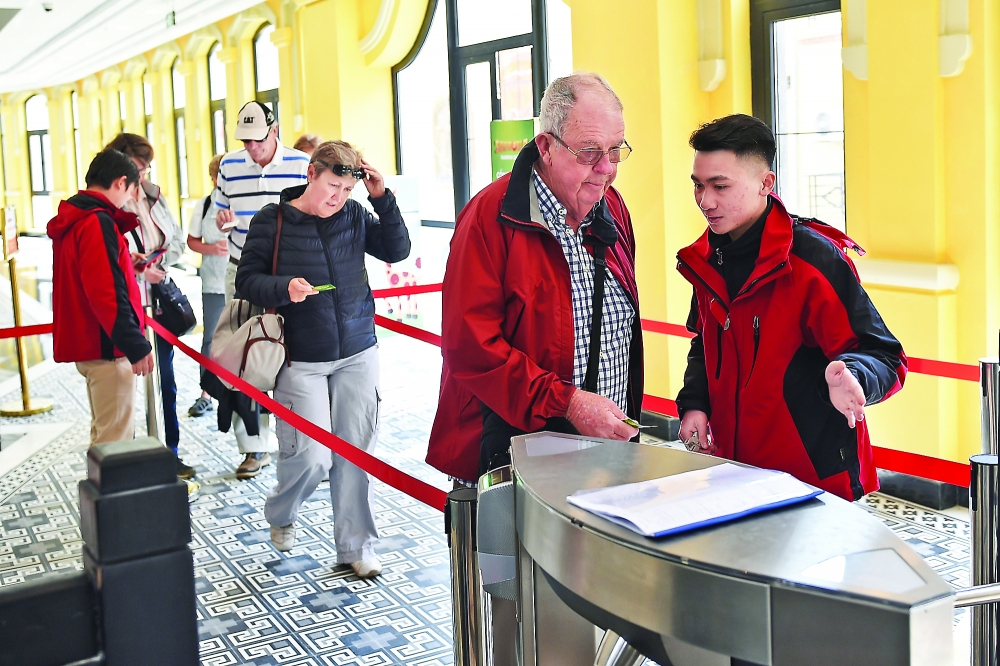The number of foreign visitors to Viet Nam in recent years has grown impressively at a rate envied by other countries in the region, but tourist spending and the tourism industry’s revenues are lagging far behind.

Foreign tourists at the Muong Hoa mountain train station to Fansipan Peak
Plenty of visitors, modest revenue
Over the past three years, the number of foreign visitors to Viet Nam has grown at an annual rate of 30 percent. In 2017, Viet Nam ranked sixth among the world’s 10 fastest growing travel destinations. In 2018, Viet Nam welcomed 15 million foreign tourists.
Despite continuous increases in the number of visitors, Viet Nam’s revenues from tourism are far lower than in other countries in the region.
According to the Viet Nam National Administration of Tourism (VNAT), foreign visitors spend an average US$900 on a trip to Vietnam, compared to US$1,105, US$1,109 and US$1,565 spent in Singapore, Indonesia, and Thailand respectively.
The relatively modest spending reflects lower prices, which, paradoxically are one of Vietnamese tourism’s major selling points. “Compared with Thailand, the average length of stay of visitors to Viet Nam is almost the same (9.5 days in Viet Nam and 9.6 days in Thailand). However, visitors to Viet Nam spend only US$96 per day, while those to Thailand spend US$163, and Singapore: US$325,” said John Lindquist, senior advisor to BCG - a member of the UK’s Tourism Industry Council.
Where to spend money?
In addition to Viet Nam’s lower prices, tourism experts attribute the modest spending to lack of opportunities for visitors to spend their money other than on sightseeing and accommodations. Even major cities such as Hanoi, Da Nang, Ho Chi Minh City, and Phu Quoc Island lack a diversity of entertainment facilities and shopping centers to serve visitors. Da Nang, a coastal tourist hub in the central region, is an example. Although it has maintained a high economic growth rate for many years and invested strongly in tourism infrastructure, the city still lacks special products and entertainment services for visitors, especially at night.
Da Nang offers beaches and sea, seafood, the Non Nuoc stone carving village and Ba Na Hills, but little else of interest to foreign visitors. “Destinations such as Phu Quoc and Da Nang are attractive to visitors, but they need to create new offerings to encourage visitors to come back. Visitors to Da Nang like Ba Na Hills, Golden Bridge and luxurious relaxation facilities such as InterContinental Danang Sun Peninsula Resort. However, these are not enough to get visitors to stay longer and encourage them to spend more money,” said Dang Bich Tho, Deputy General Director of Ha Noi Redtours.
Sharing this opinion, Nguyen Tien Dat, Deputy Director of TransViet Travel, said, “Da Nang has many tourism advantages but still lacks bars and entertainment facilities to attract visitors at night. It has night markets but they remain small-sized and sell mostly street food. From Da Nang, tourists can travel easily to Hoi An and its Old Town. However, shops, markets and other service facilities in Hoi An close early, at about 10pm, while other Asian cities often stay awake beyond midnight.”
Private investment at tourist sites in recent years has focused on providing integrated models that include diverse entertainment and shopping facilities. Examples include the Sun World Ba Na Hills complex above Da Nang, Sun World Fansipan Legend in Lao Cai, Sun World Halong Complex in Ha Long Bay, and Vinpearl sites in Nha Trang and Phu Quoc. However, these high-grade tourism products and services have not kept up with growing demand, while few private companies dare to invest in such tourist projects.
Inadequate infrastructure is a hindrance to tourism development. Kenneth Atkinson, Executive Chairman of Grant Thornton Vietnam, said that while both the quality and quantity of tourist accommodations in major Vietnamese cities have improved greatly, demand keeps growing faster than supply, reflected in increasing room charges and occupancy rates.
The question is whether increased spending options would drive up prices, making Vietnam less attractive to budget
tourism. Conversely, prices could still remain lower than those in neighboring countries, while better infrastructure and
spending options would draw many more tourists and thereby increase industry revenues.
Quynh Trang